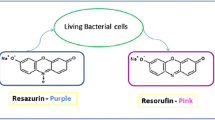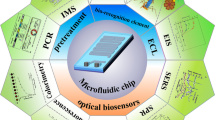Abstract
Spread of drug-resistant Staphylococcus spp. into communities pose danger demanding effective non-invasive and non-destructive tools for its early detection and surveillance. Characteristic volatile organic compounds (VOCs) produced by bacteria offer new diagnostic targets and novel approaches not exploited so far in infectious disease diagnostics. Our search for such characteristic VOC for Staphylococcus spp. led to the depiction of 2-[3-acetoxy-4,4,14-trimethylandrost-8-en-17-yl] propanoic acid (ATMAP), a moderately volatile compound detected both in the culture and headspace when the organism was grown in tryptone soya broth (TSB) medium. A simple and inexpensive colorimetric method (colour change from yellow to orange) using methyl red as the pH indicator provided an absolutely specific way for identifying Staphylococcus spp., The assay performed in liquid cultures (7-h growth in TSB) as well as in the headspace of plate cultures (grown for 10 h on TSA) was optimised in a 96-well plate and 12-well plate formats, respectively, employing a set of positive and negative strains. Only Staphylococcus spp. showed the distinct colour change from yellow to orange due to the production of the above VOC while in the case of other organisms, the reagent remained yellow. The method validated using known clinical and environmental strains (56 including Staphylococcus, Proteus, Pseudomonas, Klebsiella, Bacillus, Shigella and Escherichia coli) was found to be highly efficient showing 100 % specificity and sensitivity. Such simple methods of bacterial pathogen identification are expected to form the next generation tools for the control of infectious diseases through early detection and surveillance of causative agents.






Similar content being viewed by others
References
Aarthi R, Saranya R, Sankaran K (2014) 2-methylbutanal, a volatile biomarker, for non-invasive surveillance of Proteus. Appl Microbiol Biotechnol 98(1):445–454
Abdul GL, Anthony M (2008) Clinical tests: sensitivity and specificity. Contin Educ Anaesth Crit Care Pain 8:221–223
Allardyce RA, Hill AL, Murdoch DR (2006) The rapid evaluation of bacterial growth and antibiotic susceptibility in blood cultures by selected ion flow tube mass spectrometry. Diagn Microbiol Infect Dis 55:255–261
Anne VG (2006) Patterns of antimicrobial susceptibility among bacterial pathogens in South Africa. Monitoring susceptibility. CME 22(4):189–192
Boots AW, Smolinska A, van Berkel JJBN, Fijten RRR, Stobberingh EE, Boumans MLL, Moonen EJ, Wouters EFM, Dallinga JW, Van Schooten FJ (2014) Identification of microorganisms based on headspace analysis of volatile organic compounds by gas chromatography–mass spectrometry, IOP Publishing Ltd. doi:10.1088/1752-7155/8/2/027106
Bunge M, Araghipour N, Mikoviny T, Dunkl J, Schnitzhofer R, Hansel A, Schinner F, Wisthaler A, Margesin R, Märk TD (2008) On-line monitoring of microbial volatile metabolites by proton transfer reaction-mass spectrometry. Appl Environ Microbiol 74:2179–2186
Carey JR, Suslick KS, Hulkower KI, Imlay JA, Imlay KRC (2011) Rapid identification of bacteria with a disposable colorimetric sensing array. J Am Chem Soc 133(19):7571–7576
Cubero-Herrera L, Guy RD, Ramaley L (2006) 1-Pyrenemethanol, a useful fluorometric reagent for the detection and determination of carboxylic acids in atmospheric samples. Instrum Sci Technol 34: 239–255
Dunges W (1977) 4-Bromomethyl-7-methoxycoumarin as a new fluorescence label for fatty acids. Anal Chem 49:442–445
Elixhauser A, Steiner C (2007) Infections with methicillin-resistant Staphylococcus Aureus (MRSA) in U.S. Hospitals, 1993–2005, Agency for Healthcare Research and Quality, Published on July
Eseonu KC, Middleton SD, Eseonu CC (2011) A retrospective study of risk factors for poor outcomes in methicillin-resistant Staphylococcus aureus (MRSA) infection in surgical patients. J Orthop Surg Res 6(1):25
Gomez JE, Garcia-Vazquez R, Barios M, Canteras J, Ruiz V, Barios JA, Valdes HM (2007) Predictors of mortality in patients with methicillin-resistant Staphylococcu aureus (MRSA) bacteraemia: the role of empiric antibiotic therapy. Eur J Clin Microbiol Infect Dis 26:239–245. doi:10.1007/s10096-007-0272-x
Guernion N, Ratcliffe NM, Spencer-Phillips PT, Howe RA (2001) Identifying bacteria in human urine: current practice and the potential for rapid, near-patient diagnosis by sensing volatile organic compounds. Clin Chem Lab Med 39(10):893–906
Hospital statistics 2012–13 (2013) Staphylococcus aureus bacteraemia in Australian public hospitals, Australian Institute of Health and Welfare, ISBN 978-1-74249-525-5
Jose GR (2009) Statistical intervals: confidence, prediction, enclosure. SAS Institute Inc., USA
Kloos WE, KH Schleifer (1986) Staphylococcus, Bergey’s manual of systematic bacteriology 2:1013–1019
Kohne DE, Steigerwalt AG, Brenner DJ (1984) Nucleic acid probe specific for members of the genus Legionella, Legionella: Proceedings of the 2nd international symposium. Am Soc Microbiol: 107–108
Lee Y-M, Nakamura H, Nakajima T (1989) Fluorometric determination of carboxylic acids by high performance liquid chromatography after derivatization with monodansyl cadaverine. Anal Sci 5:681–685
Marlowe EM, Bankowski MJ (2011) Conventional and molecular methods for the detection of methicillin-resistant Staphylococcus aureus. J Clin Microbiol 49(9):S53–S56. doi:10.1128/JCM.00791-11
Nimura N, Kinoshita T (1988) 1-pyrenyldiazomethane as a fluorescent labeling reagent for liquid chromatographic determination of carboxylic acids. Anal Chem 60:2067–2070
Prakash D, Saxena RS (2013) Distribution and antimicrobial susceptibility pattern of bacterial pathogens causing urinary tract infection in urban community of Meerut City, India, ISRN Microbiol
Senecal AG, Magnone J, Yeomans W, Powers EM (2002) Rapid detection of pathogenic bacteria by volatile organic compound (VOC) analysis, U.S. Army Soldier and Biological Chemical Command (USA), Proc. SPIE 4575, Chemical and Biological Early Warning Monitoring for Water, Food, and Ground 121: doi:10.1117/12.456915.
Tait E, Perry JD, Stanforth SP, Dean JR (2013) Identification of volatile organic compounds produced by bacteria using HS-SPME-GC –MS, J Chromatogr Sci: 1–11. doi:10.1093/chromsci/bmt042
Velusamy V, Arshak K, Korostynska O, Oliwa K, Adley C, Catherine A (2010) An overview of foodborne pathogen detection: In the perspective of biosensors. Biotechnol Adv 28(2):232–254. doi:10.1016/j.biotechadv.2009.12.004
Venkatachalam M, Singaravelu G, Govindaraju K, Ahn JS (2013) PTP 1B inhibitory action of a phytochemical propanoic acid,2-(3-acetoxy-4,4,14-trimethylandrost-8-en-17-yl). Curr Sci 105:828–831
Vincent Ki MD, Coleman Rotstein MD, FRCPC (2008) Bacterial skin and soft tissue infections in adults: a review of their epidemiology, pathogenesis, diagnosis, treatment and site of care. Can J Infect Dis Med Microbiol 19(2):173–184
Acknowledgments
We are grateful to Mr. Suresh Lingham, M/s Trivitron Pvt Ltd. for clinical samples and Dr. Sridhar, Dept. of Microbiology, Sri Ramachandra University, for providing standard bacterial cultures. Our sincere thanks to P. Dineshkumar and S. Akshay for their contribution to our study. We acknowledge the financial support from Centre with Potential for Excellence in Environmental Science (CPEES) of University Grants Commission. One of the authors, R Aarthi, acknowledges CSIR for providing CSIR-SRF. We also express our deepest gratitude to our family and friends.
Conflict of interest
There is no conflict of interests among the authors for submitting this article. This work was supported by the Centre with Potential for Excellence in Environmental Science (CPEES) of University Grants Commission, India. They have no involvements in the study design; in the collection, analysis and interpretation of data; in the writing of the article and in the decision to submit the article for publication.
Author information
Authors and Affiliations
Corresponding author
Electronic supplementary material
Below is the link to the electronic supplementary material.
ESM 1
(PDF 11.1 kb)
Rights and permissions
About this article
Cite this article
Saranya, R., Aarthi, R. & Sankaran, K. Simple and specific colorimetric detection of Staphylococcus using its volatile 2-[3-acetoxy-4,4,14-trimethylandrost-8-en-17-yl] propanoic acid in the liquid phase and head space of cultures. Appl Microbiol Biotechnol 99, 4423–4433 (2015). https://doi.org/10.1007/s00253-015-6573-6
Received:
Revised:
Accepted:
Published:
Issue Date:
DOI: https://doi.org/10.1007/s00253-015-6573-6




